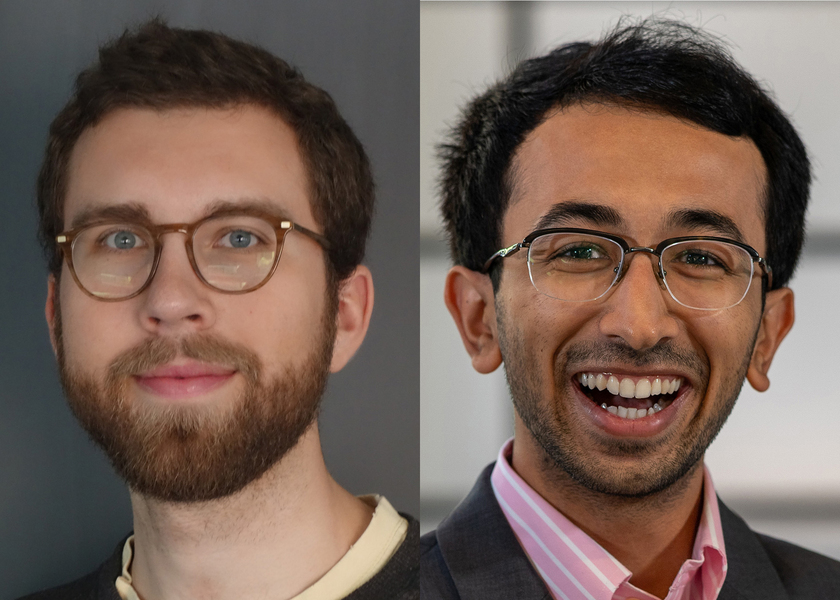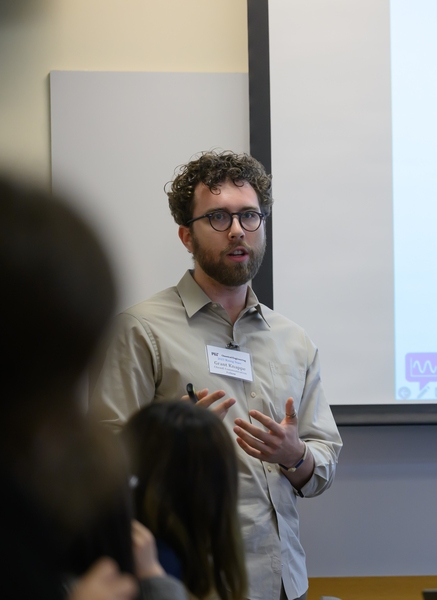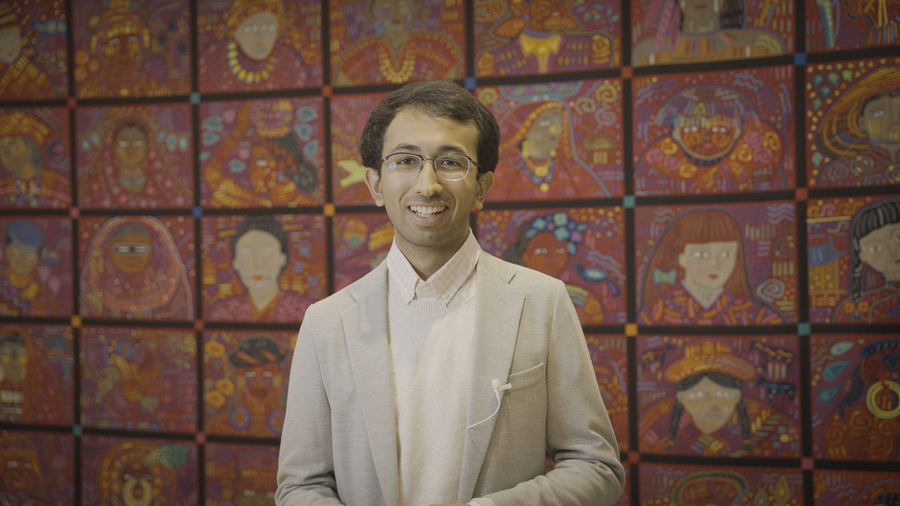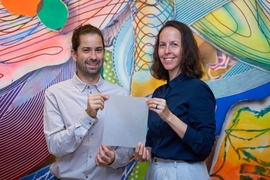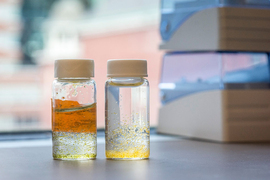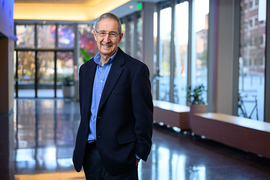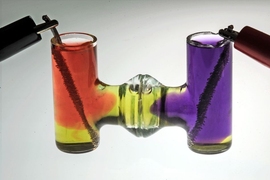Two MIT scholars, each with a strong entrepreneurial drive, have received 2024 Kavanaugh Fellowship awards, advancing their quest to turn pioneering research into profitable commercial enterprises.
The Kavanaugh Translational Fellows Program gives scholars training to lead organizations that will bring their research to market. PhD candidates Grant Knappe and Arjav Shah are this year’s recipients. Knappe is developing a drug delivery platform for an emerging class of medicines called nucleic acid therapeutics. Shah is using hydrogel microparticles to clean up water polluted by heavy metals and other contaminants.
Knappe and Shah will begin their fellowship with years of entrepreneurial expertise under their belts. They’ve developed and refined their business plans through MIT’s innovation ecosystem, including the Sandbox, the Legatum Center, the Venture Mentoring Service, the National Science Foundation’s I-Corps Program, and Blueprint by The Engine. Now, the yearlong Kavanaugh Fellowship will give the scholars time to focus exclusively on testing their business plans and exercising decision-making skills — critical to startup success — with the guidance of MIT mentors.
“It’s a testament to the support and direction they’ve received from the MIT community that their entrepreneurial aspirations have evolved and matured over time,” says Michael J. Cima, program director for the Kavanaugh program and the David H. Koch Professor of Engineering in the Department of Materials Science and Engineering.
Founded in 2016, the Kavanaugh program was instrumental in helping past fellows launch several robust startups, including low-carbon cement manufacturer Sublime Systems and SiTration, which is using a new type of filtration membrane to extract critical materials such as lithium.
A safer way to deliver breakthrough medicines
Nucleic acid therapeutics, including mRNA and CRISPR, are disrupting today’s clinical landscape thanks to their promise of targeting disease treatment according to genetic blueprints. But the first methods of delivering these molecules to the body used viruses as their transport, raising patient safety concerns.
“Humans have figured out how to engineer certain viruses found in nature to deliver specific cargoes [for disease treatment],” says Knappe. “But because they look like viruses, the human immune system sees them as a danger signal and creates an immune reaction that can be harmful to patients.”
Given the safety profile issues of viral delivery, researchers turned to non-viral technologies that use lipid nanoparticle technology, a mixture of different lipid-like materials, assembled into particles to protect the mRNA therapeutic from getting degraded before it reaches a cell of interest. “Because they don’t look like viruses there, the immune system generally tolerates them,” adds Knappe.
Recent data show lipid nanoparticles can now target the lung, opening the potential for novel treatments of deadly cancers and other diseases.
Knappe’s work in MIT’s Bathe BioNanoLab focused on building such a non-viral delivery platform based on a different technology: nucleic acid nanoparticles, which combine the attractive components of both viral and non-viral systems. Knappe will spend his Kavanaugh Fellowship year developing proof-of-concept data for his drug delivery method and building the team and funding needed to commercialize the technology.
A PhD candidate in the Department of Chemical Engineering (ChemE), Knappe was initially attracted to MIT because of its intellectual openness. “You can work with any faculty member in other departments. I wasn't restricted to the chemical engineering faculty,” says Knappe, whose supervisor, Professor Mark Bathe, is in the Department of Biological Engineering.
Knappe, who is from New Jersey, welcomes the challenges that will come in his Kavanaugh year, including the need to pinpoint the right story that will convince venture capitalists and other funders to bet on his technology. Attracting talent is also top of mind. “How do you convince really talented people that have a lot of opportunities to work on what you work on? Building the first team is going to be critical,” he says. The network Knappe has been building in his years at MIT is paying dividends now.
Targeting “forever chemicals” in water
That network includes Shah. The two fellows met when they worked on the MIT Science Policy Review, a student-run journal concerned with the intersection of science, technology, and policy. Knappe and Shah did not compete directly academically but used their biweekly coffee walks as a welcome sounding board. Naturally, they were pleased when they found out they had both been chosen for the Kavanaugh Fellowship. So far, they have been too busy to celebrate over a beer.
“We are good collaborators with research, as well,” says Shah. “Now we’re going on this entrepreneurial journey together. It’s been exciting.”
Shah is a PhD candidate in ChemE’s Chemical Engineering Practice program. He got interested in the global imperative for cleaner water at a young age. His hometown of Surat is the heart of India’s textile industry. “Growing up, it wasn’t hard to see the dye-colored water flowing into your rivers and streams,” Shah says. “Playing a role in fostering positive change in water treatment fills me with a profound sense of purpose.”
Shah’s work, broadly, is to clean toxic chemicals called micropollutants from water in an efficient and sustainable manner. “It’s humanly impossible to turn a blind eye to our water problems,” he says, which can be categorized as accessibility, availability, and quality. Water problems are global and complex, not just because of the technological challenges but also sociopolitical ones, he adds.
Manufactured chemicals called per- and polyfluoroalkyl substances (PFAS), or “forever chemicals,” are in the news these days. PFAS, which go into making nonstick cookware and waterproof clothing, are just one of more than 10,000 such emerging contaminants that have leached into water streams. “These are extremely difficult to remove using existing systems because of their chemical diversity and low concentrations,” Shah says. “The concentrations are akin to dropping an aspirin tablet in an Olympic-sized swimming pool.” But no less toxic for that.
In the lab at MIT, Shah is working with Devashish Gokhale, a fellow PhD student, and Patrick S. Doyle, the Robert T. Haslam (1911) Professor of Chemical Engineering, to commercialize an innovative microparticle technology, hydroGel, to remove these micropollutants in an effective, facile, and sustainable manner. Hydrogels are a broad class of polymer materials that can hold large quantities of water.
“Our materials are like Boba beads. We are trying to save the world with our Boba beads,” says Shah with a laugh. “And we have functionalized these particles with tunable chemistries to target different micropollutants in a single unit operation.”
Due to its outsized environmental impact, industrial water is the first application Shah is targeting. Today, wastewater treatment emits more than 3 percent of global carbon dioxide emissions, which is more than the shipping industry’s emissions, for example. The current state of the art for removing micropollutants in the industry is to use activated carbon filters. “[This technology] comes from coal, so it’s unsustainable,” Shah says. And the activated carbon filters are hard to reuse. “Our particles are reusable, theoretically infinitely.”
“I’m very excited to be able to take advantage of the mentorship we have from the Kavanaugh team to take this technology to its next inflection point, so that we are ready to go out in the market and start making a huge impact,” he says.
A dream community
Shah and Knappe have become adept at navigating the array of support and mentorship opportunities MIT has to offer. Shah worked with a small team of seasoned professionals in the water space from the MIT Venture Mentoring Service. “They’ve helped us every step of the way as we think about commercializing the technology,” he says.
Shah worked with MIT Sandbox, which provides a seed grant to help find the right product-market fit. He is also a fellow with the Legatum Center for Development and Entrepreneurship, which focuses on entrepreneurship in global growth markets.
“We’re exploring the potential for this technology and its application in a lot of different markets, including India. Because that’s close to my heart,” Shah says. “The Legatum community has been unique, where you can have those extremely hard conversations, confront yourself with those fears, and then talk it out with the group of fellows.”
The Abdul Latif Jameel Water and Food Systems Lab, or J-WAFS, has been an integral part of Shah’s journey with research and commercialization support through its Solutions Grant and a travel award to the Stockholm World Water Week in August 2023.
Knappe has also taken advantage of many innovation programs, including MIT’s Blueprint by the Engine, which helps researchers explore commercial opportunities of their work, plus programs outside of MIT but with strong on-campus ties such as Nucleate Activator and Frequency Bio.
It was during one of these programs that he was inspired by two postdocs working in Bathe’s lab and spinning out biotech startups from their research, Floris Engelhardt and James Banal. Engelhardt helped spearhead Kano Therapeutics, and Banal launched Cache DNA.
“I was passively absorbing and watching everything that they were going through and what they were excited about and challenged with. I still talk to them pretty regularly to this day,” Knappe says. “It’s been really great to have them as continual mentors, throughout my PhD and as I transition out of the lab.”
Shah says he is grateful not only for being selected for the Kavanaugh Fellowship but to MIT as a community. “MIT has been more than a dream come true,” he says. He will have the opportunity to explore a different side of the institution as he enters the MBA program at MIT Sloan School of Management this fall. Shah expects this program, along with his Kavanaugh training, will supply the skills he needs to scale the business so it can make a difference in the world.
“I always keep coming back to the question ‘How does what I do matter to the person on the street?’ This guides me to look at the bigger picture, to contextualize my research to solving important problems,” Shah says. “So many great technologies are being worked on each day, but only a minuscule fraction make it to the market.”
Knappe is equally dedicated to serving a larger purpose. “With the right infrastructure, between basic fundamental science, conducted in academia, funded by government, and then translated by companies, we can make products that could improve everyone’s life across the world,” he says.
Past Kavanaugh Fellows are credited with spearheading commercial outfits that have indeed made a difference. This year’s fellows are poised to follow their lead. But first they will have that beer together to celebrate.
